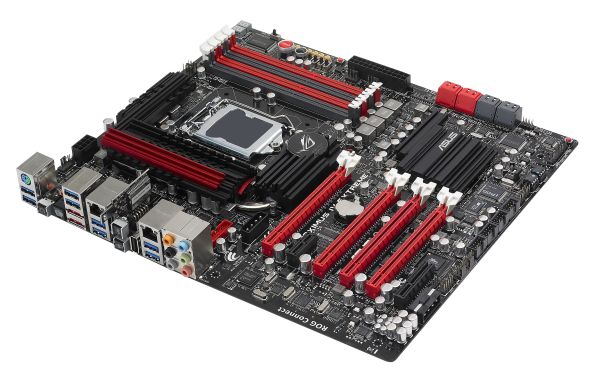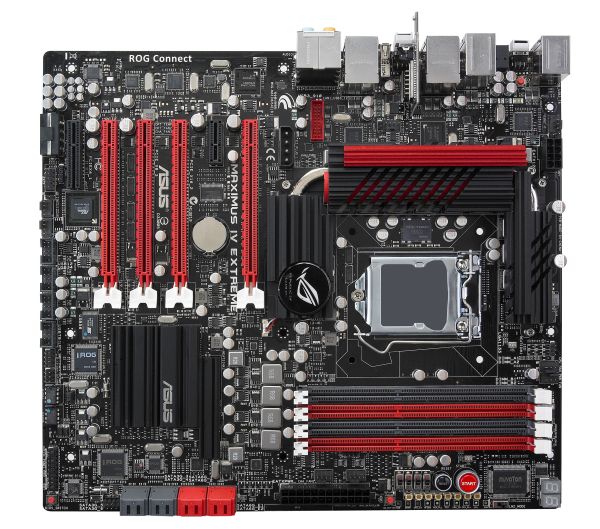A brief look at upcoming ASUS P67 Motherboards
by Ian Cutress on November 14, 2010 1:22 PM EST- Posted in
- News
- Motherboards
- Asus
The first board in the Sandy Bridge series with the Republic of Gamers moniker is the Maximus IV Extreme. This motherboard looks jam-packed with features, and we’d expect nothing less from a ROG product.
The red and black aside, ASUS are attempting to pushing the boat out for overclockers. Of immediate notice is beside the dual-channel DDR3 slots – alongside the power and reset buttons are a set of four switches, designed to enable and disable the PCIe slots as required. Beside these are a set of eight voltage readout points, allowing the monitoring of the various DRAM, NF200, PCH and the CPU voltages across the board. A switch is also present labelled ‘LN2_MODE’, which offers various questions as to what it does, but we suspect at least one of these features is to remove the overcurrent protection when the processor is under liquid nitrogen. One point of humorous mention is that there are three LEDs next to the DDR3 slots, one of them labelled ‘DDR_CRAZY’.
The Maximus IV operates a dual BIOS system, as directed by the two chips labelled BIOS1 and 2, and the BIOS switch in the bottom corner of the board. The dual-digit debugging LEDs, as we would expect, are present also.
Surprisingly, only one 8-pin 12V connector is on the board, which is somewhat odd if the board has a liquid nitrogen mode and power needs to be pumped into the CPU. In terms of extra power for the PCIe slots, a 4-pin molex connector is provided where a PCIe x1 slot is found on the Pro and Deluxe boards. The board is obviously built for multiple graphics card use and overclocking, but as the P67 chipset is designed to only hold 16 PCIe lanes for graphics card usage – ASUS have added an NF200 chip to increase the amount of available lanes, presumably to 32 for an x16/x16 or x16/x8/x8 configuration. On previous motherboard generations, the NF200 chip accounts for a 1-2% loss in performance when the lanes are not fully utilised versus native support, as well as few more extra monies and power usage, thus all the GPU lanes need to be used to get the most out of the board – this is what the consumer is paying for, after all.
The back panel offers the usual myriad of USB 2.0 / 3.0, firewire, eSATA, 5.1 audio, PS/2 and dual Ethernet connectors, but the use of a mini-PCB perpendicular to the motherboard to supply the board with Bluetooth and what looks like a ROG connect switch is interesting. Also of note is an NEC/TOKIN Proadlizer film capacitor, similar to that used on some GPUs, directly next to the socket – presumably to provide more stable power to the socket.
Apart from the possible results this motherboard may or may not achieve, one thing is certain – it will be costing the consumer a pretty penny. No doubt we will have one in to test at some point, and we’ll keep our ears to the ground on other manufacturer’s flagship Sandy Bridge boards.












53 Comments
View All Comments
ChuckDriver - Monday, November 15, 2010 - link
Since they are including Bluetooth with these motherboards, I wonder if it will be possible to access the BIOS with a Bluetooth keyboard. This has been a drawback with Bluetooth, in my opinion; especially when you consider that a proprietary RF wireless keyboard doesn't have this problem. Few people will care about this, but it has bothered me for a long time. I read that Anycom made a BT dongle (I think the USB-500) where this was possible, but Anycom appears to be out of business.JessusChristDoOTcom - Monday, November 15, 2010 - link
I second this notion.ClagMaster - Monday, November 15, 2010 - link
This P67 motherboard looks like a worthy successor to their P55 motherboards.I noticed the clamping device has a fairly large CPU bearing surface so there is no tilting of the CPU in the socket that can cause pins to melt at high overclock.
But I do not think the quality is there as in the P55 boards released a year ago.